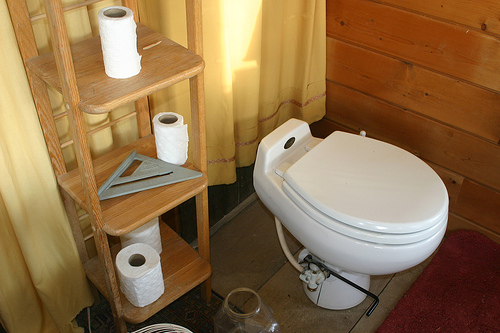Composting toilets (also called “dry sanitation systems”) have been in existence for over thirty years and during this time, have been used broadly in rural settings and other locales where centralized wastewater treatment is not feasible. Composting toilet systems differ fundamentally from conventional toilet systems in that they do not make use of potable water to transport human waste off-site for treatment, but rather contain waste on-site where pathogens are killed and nutrients are recycled in localized biological cycles.
 (Figure 1: Typical Composting Toilet) (Figure 1: Typical Composting Toilet)
Though early application of composting toilets in the U.S. was largely limited to rustic and outdoor settings, this simple technology is now gaining increased attention for its potential use in urban settings due to a number of appealing environmental advantages over conventional systems:
- No potable water is required for the system to function properly – this results in significant water conservation benefits (up to 30% savings.) A conventional toilet uses up to 5 gallons of potable water per ounce of human waste.
- Because no black water (sewage water) is created, the need to treat sewage water before releasing it into receiving waters is eliminated. Furthermore, because other household grey water sources (laundry, kitchen, shower) are not mixed with human waste, these sources become more viable for reuse on-site.
- Composting toilets, when designed and maintained properly, control pathogens at their source. This reduces the potential for soil and groundwater contamination from deteriorating conventional piping infrastructure.
- The energy (and CO2 equivalent) required to build and maintain
distributed composting toilet systems is significantly lower than that
required for centralized waste water treatment facilities and associated piping and pumping infrastructure
- Disruption to ecological systems (soil structure, tree root systems, etc.) during pipeline installation (or repair) is eliminated.
- Because composting toilet systems do not produce black water, they do not contribute to combined-sewer overflow events which is particularly beneficial in areas where this is an environmental and regulatory concern.
- Composting toilets provide the infrastructure to recycle other organic household waste, such as food scraps, paper and lawn clippings, on site.
- Composting toilet systems produce a useful and valuable product (compost) that can be reinvested on-site to build soil structure and soil fertility. In conventional systems, this potential resource is landfilled.
These advantages notwithstanding, concerns about the safety of composting toilets (from a public health perspective) still present a considerable obstacle to their broad application in urban settings. The laws governing composting toilets in Washington State are summarized and referenced in the “Application” section of this article.
|


 (Figure 1: Typical Composting Toilet)
(Figure 1: Typical Composting Toilet)